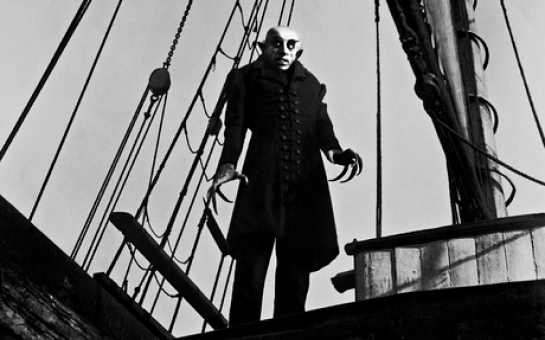FW Murnau – Nosferatu (1922)
This terrifying silent film of Dracula made by Murnau in 1922 is a masterpiece of German expressionist art. It is a hugely original creation, with a vampire who looks like a ghoul or rat-man prowling about, casting deathly shadows. In fact the appearance of Nosferatu's undead creature echoes such expressionist paintings as Munch's Scream and Schoenberg's self-portraits. Like these expressionists, Murnau uses grotesque and strange images to touch the inner mind.Lucas Cranach the Elder – The Werewolf or The Cannibal (c 1510-1515)Vampire legends originally come from eastern Europe, while Frankenstein's monster was invented by Mary Shelley and horror stories about mummies are Victorian. But the werewolf is west European folklore and so has the oldest artistic associations. This 16th-century woodcut by one of the greatest German Renaissance artists depicts a werewolf terrorising German villagers nearly 500 years ago. A wild man crawling on all fours has emerged from the forest to prey on human flesh. It must be true, I saw it in the woodcut news.Edvard Munch – Vampire (1893)In this eerie painting a woman appears to be sinking her teeth into a man's neck. To object that Munch originally gave it a different title and insisted she was kissing (not biting) him is beside the point, for this darkly erotic image of sex as danger shares the late 19th-century mood of morbid curiosity and psychic peril that produced Bram Stoker's novel Dracula. Munch's image dates from 1893; Stoker's story appeared in 1897.Leon Kossoff – Self-Portrait (1981)In this tormented expressionist self-portrait the British painter Leon Kossoff looks like Frankenstein's monster as played by Boris Karloff. The painting even has a monochrome quality that recalls the 1931 Karloff classic. This similarity between a serious painting and the finest of the old Universal horror films just goes to show how the image of the stumbling, lonely, doomed monster created by Karloff has sunk into the modern imagination. Intentionally or not, Kossoff has painted himself as Karloff.Ancient Egypt – Ka Statue (c 1800-1700 BC)It was Victorian horror writers who first saw the gothic potential of mummified human remains from ancient Egypt. Bram Stoker, author of Dracula, wrote an elaborate novel about a deathless Egyptian queen, but Arthur Conan Doyle (Sherlock's creator) went further when he told tales about mummies rising from their coffins. This extraordinary lifesize wooden statue in the Egyptian Museum, Cairo, appears to show a dead person leaving the tomb. It is the spiritual "ka" of the deceased – more a ghost than a mummy but spooky nonetheless.Neo-Assyrian – Bronze Head of Pazuzu (c 800-550 BC)This ancient near eastern demon is part of the mythology of the first cities. The early urban societies of Mesopotamia believed in powerful deities of sexuality and magic. But Pazuzu started a second life in 1973 when his resemblance to a devil from European art made him the face of evil in William Friedkin's horror film The Exorcist. The film starts with Max von Sydow staring at a statue of this demon in a windswept ruined city, knowing he is looking at the devil.Gustave Dore – Little Red Riding Hood (1867)Werewolf legends were current in France as late as the 18th century, when monstrous wolves terrorised the countryside. Perrault's fairy tales, written in the age of Versailles, include Red Riding Hood that surely draws on this fear of the wolf man. Dore's great 19th-century illustration captures the story's true darkness.Dosso Dossi – Nymph and Satyr (1510-16)The savage creature who snarls at a terrified woman in this painting is in theory a classical Satyr, but looks more like a werewolf. It is surely a fusion of the two beliefs. Werewolves were a living folk belief in 16th-century Italy when Dossi painted this at the court of Ferrara. Peasants believed they had to fight werewolves at night to protect their crops. Dosso Dossi goes to the dark heart of the werewolf myth, as he paints the beast in man.Thomas Phillips – Byron (1813)The first vampire story in English literature, The Vampyre (1819) was wrtten by John Polidori, travelling companion of the romantic poet, radical hero and notorious cad Lord Byron. In this portrait Byron poses in the costume of an Albanian bandit. In Polidori's tale it is in Greece that the hero realises his fellow traveller the sinister, seductive, ie Byronic aristocrat Lord Ruthven is a vampire. Byron is clearly the model for The Vampyre and, ultimately, for our modern fascination with undead gentlemen.Andy Warhol – Dracula (1981)Lots of people saw Warhol as a vampiric figure who preyed on the vulnerable fame-hungry souls that were drawn to his silver-walled studio the Factory. Here he gives them satisfaction, with an image of Dracula that looks suspiciously like Andy dressed up for Halloween. In fact it comes from a series of prints about "myths" and makes the indisputable point that Dracula is part of modern folklore and belongs in art just as the Greek gods once did.(theguardian.com)Bakudaily.az
Follow us !











